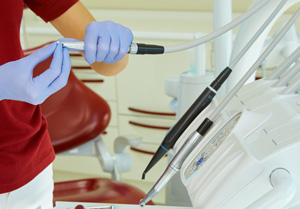Identifying Periodontal Disease
 It is important to brush two times a day and floss daily to help keep your teeth and gums healthy. It is also important to get routine check-ups and cleanings. During these routine hygiene appointments, your hygienist scales your teeth and gumline to remove plaque and tarter. Your teeth are also polished and smoothed.
It is important to brush two times a day and floss daily to help keep your teeth and gums healthy. It is also important to get routine check-ups and cleanings. During these routine hygiene appointments, your hygienist scales your teeth and gumline to remove plaque and tarter. Your teeth are also polished and smoothed.
When bacteria and tartar are not removed, they can accumulate around the gumline causing damage to the tissues that support your teeth. Periodontal disease can develop. Periodontal disease can be painless so it is important to be aware of the following symptoms.
- Red, bleeding or swollen gums (gingivitis)
- Gums that recede (move away) from the tooth, exposing more of the tooth surface
- Persistent bad breath or bad taste
- Loose teeth
- Visible pus surrounding teeth or gums
When these symptoms are present and/or during an initial comprehensive exam in our office, Dr. Fernandez, Dr. Cox or our hygienist will measure the top of the gumline to where the gum attaches to each tooth (gum pockets). The process of taking these measurements is called Periodontal Charting. Healthy gum tissue fits tightly around each tooth and these measurements should only be 1-3 millimeters deep. These pocket depths can increase as your gums recede from your teeth. If you exhibit the above symptoms and have pocket measurements of 4 millimeters or greater, a scaling and root planing procedure (deep cleaning) may be recommended to treat your periodontal disease.
The Procedure
The scaling and root planing procedure is generally completed in two appointments, cleaning half of your mouth (right or left side) during each appointment.
We will use a local anesthetic to numb the area and minimize discomfort. Our hygienist will then scale all your teeth and root surfaces removing all plaque, tartar and bacteria from the teeth and root surfaces. Your root surfaces will be smoothed (root planing) which helps keep bacteria, plaque and tartar from re-adhering below the gumline. This allows your gums to heal and reattach themselves to your teeth.
Care After Scaling and Root Planing Procedure
Six to eight weeks after you have had scaling and root planing you will come back to our office so we can check the healing of your gums. Our hygienist will do fine scaling to remove any remaining tartar or plaque. In extreme cases where healing has not occurred, surgical intervention may be necessary.
Depending on the severity of your periodontal disease, our hygienist will put you on a periodontal maintenance schedule in our office, with appointments generally every 3-4 months. These maintenance visits consist of routine cleanings and careful examination of your gum tissue and measurements of your gum pocket depth in the affected areas.
Prevention of Periodontal Disease
The best way to prevent periodontal disease is to practice good oral hygiene and visit our office for routine professional cleanings.
- Brush at least twice daily and floss daily
- Replace your toothbrush when bristles are worn
- Consider using an antimicrobial mouthwash daily
- Don’t smoke. Smoking can contribute to the advance of periodontal disease

